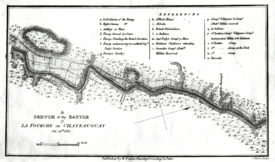Battle of the Chateauguay facts for kids
Quick facts for kids Battle of the Chateauguay |
|||||||
|---|---|---|---|---|---|---|---|
| Part of the War of 1812 | |||||||
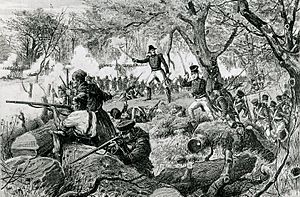 Bataille de la Chateauguay by Henri Julien. Lithograph from Le Journal de Dimanche, 1884. |
|||||||
|
|||||||
| Belligerents | |||||||
| Commanders and leaders | |||||||
| Strength | |||||||
| 1,530 | 2,600 | ||||||
| Casualties and losses | |||||||
| 22 killed, wounded or missing |
85 killed, wounded or missing |
||||||
| Official name: Battle of the Châteauguay National Historic Site of Canada | |||||||
| Designated: | 1920 | ||||||
The Battle of the Chateauguay was an important fight during the War of 1812. On October 26, 1813, a combined force of British and Canadian soldiers, along with Native Americans, stopped an American army. This smaller force of about 1,530 men was led by Charles de Salaberry. They successfully defended against about 2,600 American soldiers. The Americans were trying to invade Lower Canada and attack the city of Montreal.
The Battle of the Chateauguay, along with the Battle of Crysler's Farm, made the Americans give up their plan to invade Canada. This was a big win for the British and Canadians in the autumn of 1813.
Contents
Planning the Attack: The American Strategy
In late 1813, United States Secretary of War John Armstrong created a plan to capture Montreal. Taking Montreal could have led to the Americans controlling all of Upper Canada. His plan involved two main groups of soldiers.
Two Armies March on Montreal
- One group would travel down the St. Lawrence River from Sackett's Harbor. This town was located on Lake Ontario.
- The second group would march north from Plattsburgh. This city was on Lake Champlain.
The two American armies were supposed to meet outside Montreal. Then, they would attack the city together.
General Hampton's Concerns
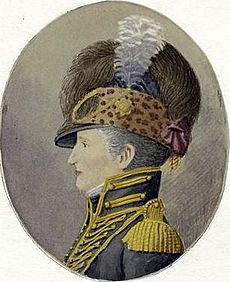
Major General Wade Hampton led the American forces near Lake Champlain. He took command on July 4, 1813. Hampton had several worries about the plan. His soldiers were new and not well-trained. Even his younger officers lacked experience.
Supplies were also a problem at his base in Plattsburgh. The British had controlled Lake Champlain since June 3. On that day, two American ships were trapped and captured by British gunboats. The British then used these ships to raid towns around Lake Champlain. They destroyed many supplies in Plattsburgh.
Hampton also disliked Major General James Wilkinson, who led the other American army. The two generals had been arguing since 1808. Hampton at first refused to take orders from Wilkinson. Secretary Armstrong had to step in to make sure they worked together.
Hampton's March to Chateauguay
On September 19, Hampton moved his troops from Burlington to Plattsburgh. He then tried to advance north towards Odelltown. However, he found the British forces there were too strong. The British had about 900 soldiers at Île aux Noix, where their ships were based. Also, there was not enough water on this route due to a dry summer.
So, Hampton decided to march his army west instead. They went to Four Corners, a place on the Chateauguay River.
Waiting for Wilkinson's Army
Hampton's army waited at Four Corners until October 18. He worried that the delay was using up his supplies. It also gave the British more time to gather their forces. When he heard that Wilkinson's army was "almost" ready, Hampton began moving down the Chateauguay River.
A group of 1,400 New York militia soldiers refused to cross into Canada. This left Hampton with about 2,600 regular soldiers. He also had 200 mounted troops and 10 cannons. Many supply wagons slowed his army's progress. The Canadians had destroyed bridges and cut down trees across the roads.
Canadian Defenses: Preparing for Battle
Major-General Louis de Watteville was put in charge of the Montreal area on September 17. When he heard about the American advance, he called up several militia units. Reinforcements, two battalions of Royal Marines, also moved up the St. Lawrence River.
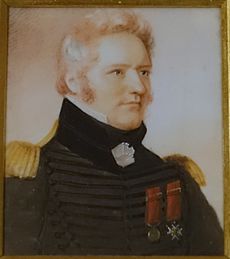
The Governor-General, Sir George Prevost, ordered Lieutenant Colonel George MacDonnell to move his soldiers to the front. However, Lieutenant Colonel Charles de Salaberry was already setting up defenses. He used his own soldiers, the Canadian Voltigeurs, and other militia units.
De Salaberry had many local farmers who gave him good information. They told him how strong Hampton's army was and where it was moving. Hampton, on the other hand, had very little information about de Salaberry's forces.
De Salaberry's Clever Defenses
The road Hampton was using followed the north bank of the Chateauguay River. De Salaberry chose a good spot where a creek joined the river. Here, he ordered his men to build obstacles called abatis. These were made of felled trees, blocking the road.
Behind these obstacles, de Salaberry placed his forward troops:
- About 50 men from the Canadian Fencibles.
- Around 100 Canadian Voltigeurs.
- About 100 local militia from Beauharnois.
- Roughly two dozen Native Americans (Abenaki, Algonquin, and Iroquois).
To protect a ford (a shallow place to cross the river) about a mile behind the abatis, de Salaberry placed more troops. These included about 160 men from the Select Embodied Militia and Beauharnois militia.
Canadian Reserve Forces
De Salaberry also had several reserve positions. These stretched for a mile and a half along the river. They included:
- About 300 more Canadian Voltigeurs.
- 480 men from the 2nd Select Embodied Militia.
- 200 more local militia.
- 150 Kahnawake and Mohawks and other Native Americans.
De Salaberry personally led the front line. Lieutenant Colonel MacDonnell commanded the reserve forces. All of de Salaberry's soldiers were from Lower Canada. The Fencibles and Voltigeurs were like regular soldiers. The Select Embodied Militia were men chosen for a year of full-time service.
De Salaberry was so sure of his plan that he did not tell his commanders. However, when the fighting started, Governor-General Prevost arrived and approved de Salaberry's setup.
The Battle of Chateauguay
Hampton knew about the ford across the river. Late on October 25, he decided to send 1,500 men under Colonel Robert Purdy to cross the river. Purdy's group was supposed to go around the Canadian position. Their goal was to capture the ford at dawn. Meanwhile, the rest of Hampton's army, led by Brigadier General George Izard, would attack from the front.
After Purdy left, Hampton received a letter. It told him that Secretary Armstrong was giving up command. This left Wilkinson in charge of all American forces. Hampton was also told to build winter camps for 10,000 men. Hampton thought this meant the attack on Montreal was off. He would have retreated, but Purdy's men would have been left alone.
Purdy's Difficult March
Purdy's men had a terrible night. They marched through swampy woods in heavy rain and got lost. As dawn broke on October 26, they found the right path. But their guides led them to the wrong spot, opposite de Salaberry's front lines.
Sometime after noon, Purdy's soldiers met the Canadian troops guarding the ford. Captain Daly, leading the 3rd Select Embodied Militia, immediately attacked the Americans. Other Canadian soldiers fired at them from across the river. The Americans became confused and were pushed back. Captain Daly and Captain Brugière were badly wounded. When the Americans tried to follow, they were again fired upon from the north bank. This made them fall back again.
Izard's Frontal Attack
After Purdy's group had been fighting for some time with no success, Izard's army marched into the ravine. They lined up facing de Salaberry's defenses. It is said that an American officer rode forward to demand the Canadians surrender. Since he did not use a flag of truce, de Salaberry himself shot him down.
Izard's troops began firing steadily into the abatis and trees. These traditional tactics were not effective against the Canadians. The Canadian defenders fired back with accurate shots. One soldier said that their shots were so well aimed that they hit at chest or head height.
On the Canadian right, some Fencible soldiers were outflanked and fell back. But Lieutenant Colonel MacDonnell and other reserve companies were already moving forward. They made bugle calls, cheered, and gave Indian war whoops. De Salaberry also sent buglers into the woods to sound "Advance." This trick made the Americans think they were outnumbered. They believed they were about to be surrounded and fell back three miles. Hampton's four cannons were never used.
Purdy first fell back to the river bank opposite de Salaberry's front line. He expected Izard to still be fighting. Instead, he found himself under fire from de Salaberry again. He had to retreat through the woods to where he started. After another bad night in the woods, the American army withdrew in good order. De Salaberry did not chase them.
Battle Results: Casualties and Aftermath
De Salaberry reported that 2 Canadians were killed, 16 were wounded, and 4 were missing. The Americans officially reported 23 killed, 33 wounded, and 29 missing. De Salaberry also said that 16 American prisoners were captured.
Hampton's Retreat and Wilkinson's Decision
After the battle, Hampton gathered his forces. He held a meeting with his officers. They all agreed that another attack would not work. The roads were also becoming very muddy from the autumn rains. Hampton's supplies were also running low.
Hampton ordered his army to retreat to Four Corners. He sent a report to Wilkinson about his situation. Wilkinson's army was near Ogdensburg when they got this news. Wilkinson ordered Hampton to advance to Cornwall, bringing supplies for both armies.
Hampton believed this order could not be followed. He refused and retreated to Plattsburgh instead. Before Hampton's reply reached Wilkinson, Wilkinson's own army was defeated at the Battle of Crysler's Farm on November 11. Wilkinson then used Hampton's refusal as an excuse to stop his own advance. The entire plan to capture Montreal was called off.
Hampton had already resigned from the army the day before the Battle of Chateauguay. He was never given another command in the field.
Canadian Recognition and Legacy
On the British side, the victorious troops at Chateauguay stayed in their positions. They faced discomfort for several days. When Native Americans reported that the Americans were retreating, they could finally return to more comfortable camps.
De Salaberry was angry that Major General de Watteville and Sir George Prevost arrived late. They took credit for the victory in their reports. De Salaberry thought about resigning. However, he was later thanked by the Legislative Assembly of Quebec. He and Lieutenant Colonel MacDonnell were honored after the war for their roles in the battle. Sir George Prevost's report said that 300 Canadians had made 7,500 Americans run away. This helped the battle become a famous story in Canadian history.
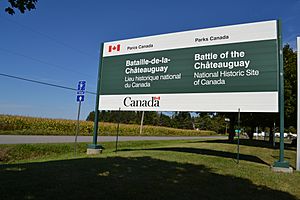
The site of the battle was named a National Historic Site of Canada in 1920.
Military Honors and History
Today, eight active battalions of the United States Army carry on the history of American infantry regiments that fought at Chateauguay. These include parts of the 1st, 4th, 25th, and 29th Infantry Regiments.
Six regiments of the Canadian Army have the Battle Honour CHATEAUGUAY. This remembers the history of the units that fought there. These regiments are: The Royal 22e Régiment, the Canadian Grenadier Guards, the Black Watch (Royal Highland Regiment) of Canada, Les Voltigeurs de Québec, Les Fusiliers du St-Laurent and Le Régiment de la Chaudière.
Mohawk Warriors at Chateauguay
Many Mohawk warriors from Kanesatake and Kahnawake fought bravely at the Battle of Chateauguay. They later received medals for their service. A list from August 25, 1847, names these warriors. Their names can be found in old parish registers and census records.
Some of the Mohawk warriors from Caughnawaga-Kahnawake who received medals were:
- Ducharme Dominique, Captain
- Anaicha, Saro
- Anontara, Saro
- Arenhoktha, Saro
- Arosin-Arosen, Wishe
- Atenhara, Henias
- Honenharakete, Roren
- Kanewatiron, Henias
- Karakontie, Arenne
- Karenhoton, Atonsa
- Kariwakeron, Sak
- Katstirakeron, Saro
- Maccomber Jarvise
- Nikarakwasa, Atonsa
- Sakahoronkwas, Triom
- Sakoiatiiostha, Sose
- Sakoratentha, Sawatis
- Saskwenharowane, Saro
- Sawennowane, Atona
- Skaionwiio, Wishe
- Taiakonentakete, Wishe
- Tekanasontie, Martin
- Tewasarasere, Roiir
- Tewaserake, Henias
- Thoientakon, Simon
- Tiohakwente, Tier
- Tiohatekon, Atonsa
- Tseoherisen, Tier
- Tsiorakwisin, Rosi
See also
 In Spanish: Batalla de Châteauguay para niños
In Spanish: Batalla de Châteauguay para niños


